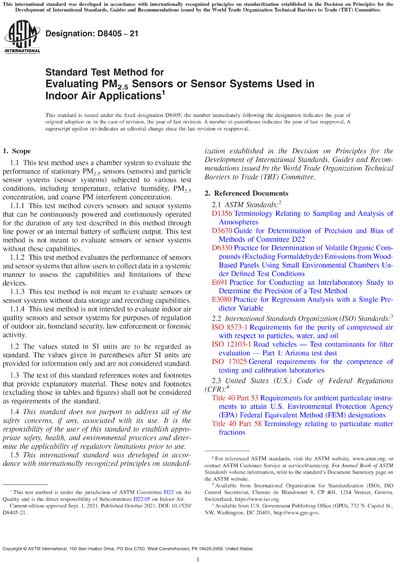Most recent
ASTM D8405-21
Standard Test Method for Evaluating PM2.5 Sensors or Sensor Systems Used in Indoor Air Applications
1.1This test method uses a chamber system to evaluate the performance of stationary PM2.5 sensors (sensors) and particle sensor systems (sensor systems) subjected to various test conditions, including temperature, relative humidity, PM2.5 concentration, and coarse PM interferent concentration.
1.1.1This test method covers sensors and sensor systems that can be continuously powered and continuously operated for the duration of any test described in this method through line power or an internal battery of sufficient output. This test method is not meant to evaluate sensors or sensor systems without these capabilities.
1.1.2This test method evaluates the performance of sensors and sensor systems that allow users to collect data in a systemic manner to assess the capabilities and limitations of these devices.
1.1.3This test method is not meant to evaluate sensors or sensor systems without data storage and recording capabilities.
1.1.4This test method is not intended to evaluate indoor air quality sensors and sensor systems for purposes of regulation of outdoor air, homeland security, law enforcement or forensic activity.
1.2The values stated in SI units are to be regarded as standard. The values given in parentheses after SI units are provided for information only and are not considered standard.
1.3The text of this standard references notes and footnotes that provide explanatory material. These notes and footnotes (excluding those in tables and figures) shall not be considered as requirements of the standard.
1.4This standard does not purport to address all of the safety concerns, if any, associated with its use. It is the responsibility of the user of this standard to establish appropriate safety, health, and environmental practices and determine the applicability of regulatory limitations prior to use.
1.5This international standard was developed in accordance with internationally recognized principles on standardization established in the Decision on Principles for the Development of International Standards, Guides and Recommendations issued by the World Trade Organization Technical Barriers to Trade (TBT) Committee.
Content Provider
ASTM International [astm]






